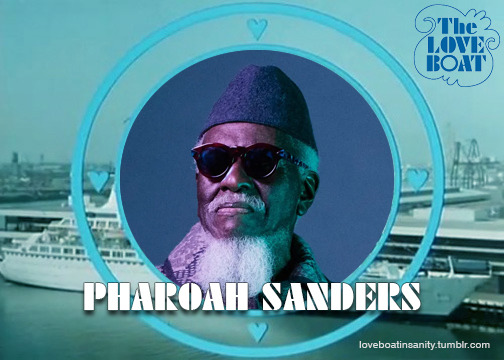#pharoah sanders
Explore tagged Tumblr posts
Text

pharoah sanders in the tunnel
(reference. one of my favorite videos of all time)
2K notes
·
View notes
Text

1966 - John Coltrane Quintet - Shinjuku Kosei Nenkin Hall - Tokyo
John Coltrane (ss, as, ts), Alice Coltrane (p), Pharoah Sanders (as, ts, bcl), Jimmy Garrison (b), Rashied Ali (dr)
129 notes
·
View notes
Text

Pharoah Sanders & John Coltrane
139 notes
·
View notes
Text

In 1961, after having played with free-jazz luminaries like Sun Ra, Don Cherry, and Billy Higgins, saxophonist Pharoah Sanders found himself homeless, working menial jobs, and sleeping on the subway. Things had gotten so bad that he had to pawn his horn for food. It wasn’t until 1964, when John Coltrane asked Sanders to sit in with his band, that things began to change.
Pharoah Sanders & John Coltrane, Ascension session, June 1965.
Photo by Chuck Stewart.
31 notes
·
View notes
Text

21 notes
·
View notes
Text

#alice coltrane#journey in satchidananda#something about john coltrane#pharoah sanders#cecil mcbee#rashied ali
42 notes
·
View notes
Text
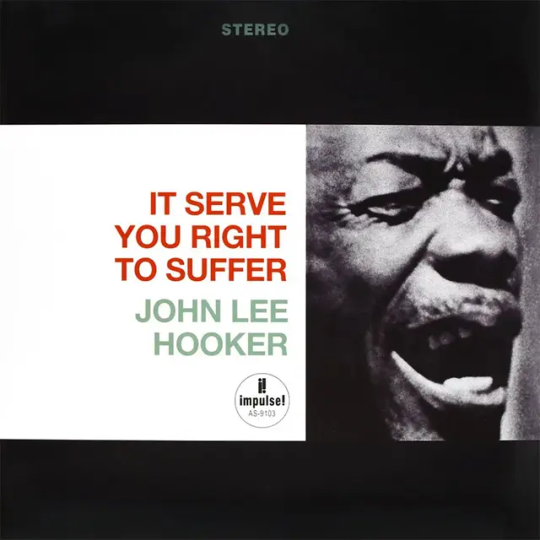


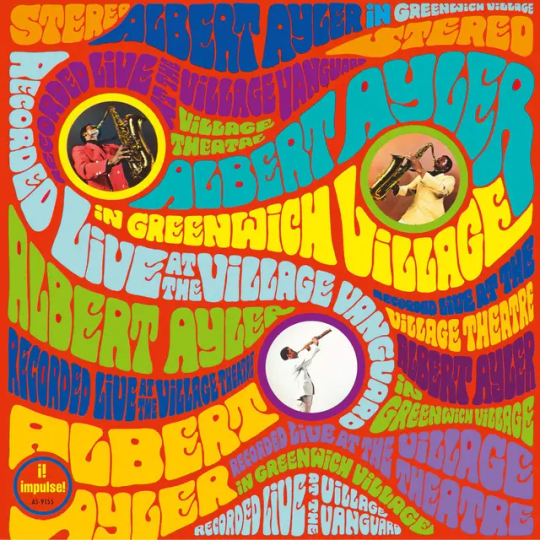


Album covers designed by Robert Flynn (those in the second column also designed with Barbara Flynn) for Impulse! Records from 1963 - 1969
#jazz#blues#pharoah sanders#charles mingus#john coltrane#albert ayler#archie shepp#john lee hooker#impulse records#impulse! records#free jazz#graphic design
20 notes
·
View notes
Text

1971
8 notes
·
View notes
Text

Spiritual jazz (or astral jazz)[1] is a sub-genre of jazz that originated in the United States during the 1960s. The genre is hard to characterize musically but draws from free, avant-garde and modal jazz and thematically focuses on transcendence and spirituality. John Coltrane's 1965 album A Love Supreme is considered landmark in the genre.

Origins
Pharoah Sanders in 1981.
Critics usually associate spiritual jazz with the 1960s but the beginnings of the genre can be traced to the 1940s and 1950s in works such as Black, Brown and Beige by Duke Ellington, Zodiac Suite by Mary Lou Williams, and Jazz at the Vespers by George Lewis.
During the 1960s in the United States, the civil rights movement was occurring, causing societal change and political movements. As a result, African-American people gained more freedom to celebrate their culture and to express themselves religiously. This led to a desire to push the conventions of jazz, with some artists choosing to search for transcendence and spirituality in their music.
John Coltrane's 1965 album A Love Supreme is generally considered the genesis of spiritual jazz though Coltrane can be heard developing the sound on the song "Spiritual" recorded four years earlier. Treblezine wrote "Spiritual jazz begins, essentially, with John Coltrane," while Pitchfork wrote "This musical exploration [of spirituality] was epitomized by tenor saxophonist John Coltrane". A Love Supreme and other works by John Coltrane inspired other jazz musicians to create music searching for transcendence. For example, Pharoah Sanders and Don Cherry were considered to have taken inspiration from Coltrane's spiritual works.
After John Coltrane's death in 1967, his wife Alice Coltrane and Sanders—both who had previously played with Coltrane—were some of the first to continue the sound of the genre. Coltrane's 1971 album Journey in Satchidananda combined spiritual jazz with influences from Hindustani classical music, after her journey into spirituality with help from Swami Satchidananda. Journey in Satchidananda used ragas, harps, sitars, and ouds to achieve its sound. Pharoah Sanders took inspiration from Arabic, Indian, and Afro-Cuban music to create early spiritual jazz albums, including Tauhid (1967) and Karma

#african#afrakan#kemetic dreams#africans#brownskin#afrakans#brown skin#african culture#afrakan spirituality#jazz spirituality#spiritual jazz#afro cuban music#pharoah sanders#tauhid#journey in satchidananda#ragas#harps#sitars#ouds#Kamasi Washington#alice coltrane#duke ellington#miles davis#african music
56 notes
·
View notes
Text

#floating points#pharoah sanders#london symphony orchestra#electronic#jazz#modern classical#Bandcamp
10 notes
·
View notes
Text
John Coltrane’s last band in the recording studio, 1966. Trane in front, Pharoah Sanders with flute and tenor sax, Rashied Ali way in the back on drums, Jimmy Garrison on bass, Alice Coltrane at the piano
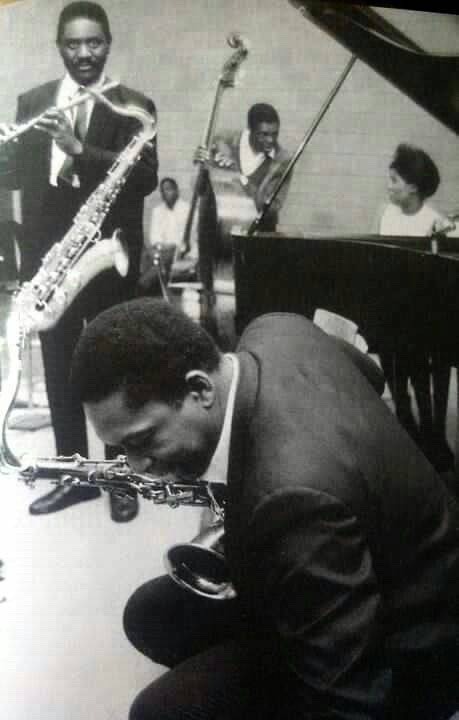
#music#jazz#20th century#photography#john coltrane#pharoah sanders#alice coltrane#jimmy garrison#Rashied Ali
14 notes
·
View notes
Text
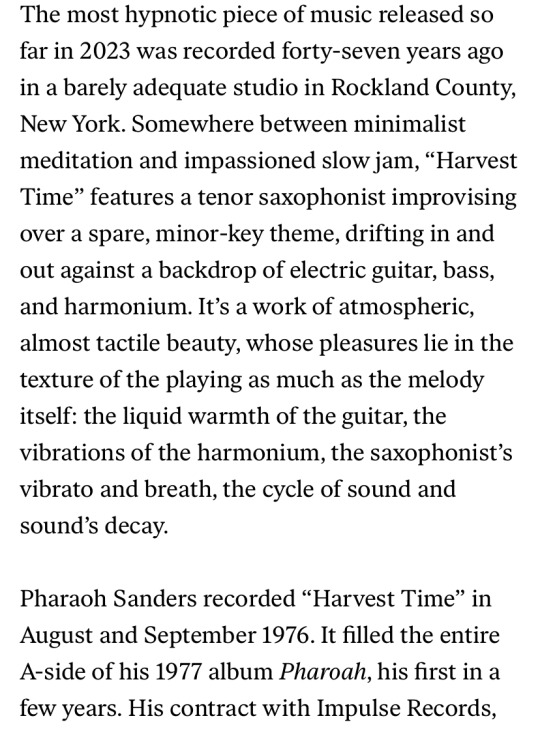
@sembulapeyalneerpol have you heard this yet??
50 notes
·
View notes
Text

Alice Coltrane, Jimmy Carrison, John Coltrane, Rashied Ali, and Pharoah Sanders in Coda (October 1976)
#alice coltrane#jimmy carrison#john coltrane#rashied ali#pharoah sanders#jazz#free jazz#spiritual jazz#newport jazz festival
6 notes
·
View notes
Text

9 notes
·
View notes
Text
John Gilmore: The Sonic Architect of Avant-Garde Jazz
Introduction: In the pantheon of jazz, where the names of saxophonists like John Coltrane, Sonny Rollins, and Charlie Parker loom large, one figure remains shrouded in mystery yet revered among musicians and aficionados: John Gilmore. A central figure in the avant-garde movement, Gilmore spent most of his career as the tenor saxophonist for Sun Ra’s Arkestra, playing a key role in shaping the…
#&039;S Make It#A Love Supreme#Albert Ayler#Andrew Hill#Arkestra#Art Blakey#Art Blakey and the Jazz Messengers#Ascension#Charlie Parker#David S. Ware#Earl Hines#Harlem Globetrotters#Jazz History#Jazz Saxophonists#John Coltrane#John Gilmore#Paul Bley#Pharoah Sanders#Sonny Rollins#Sun Ra
6 notes
·
View notes
